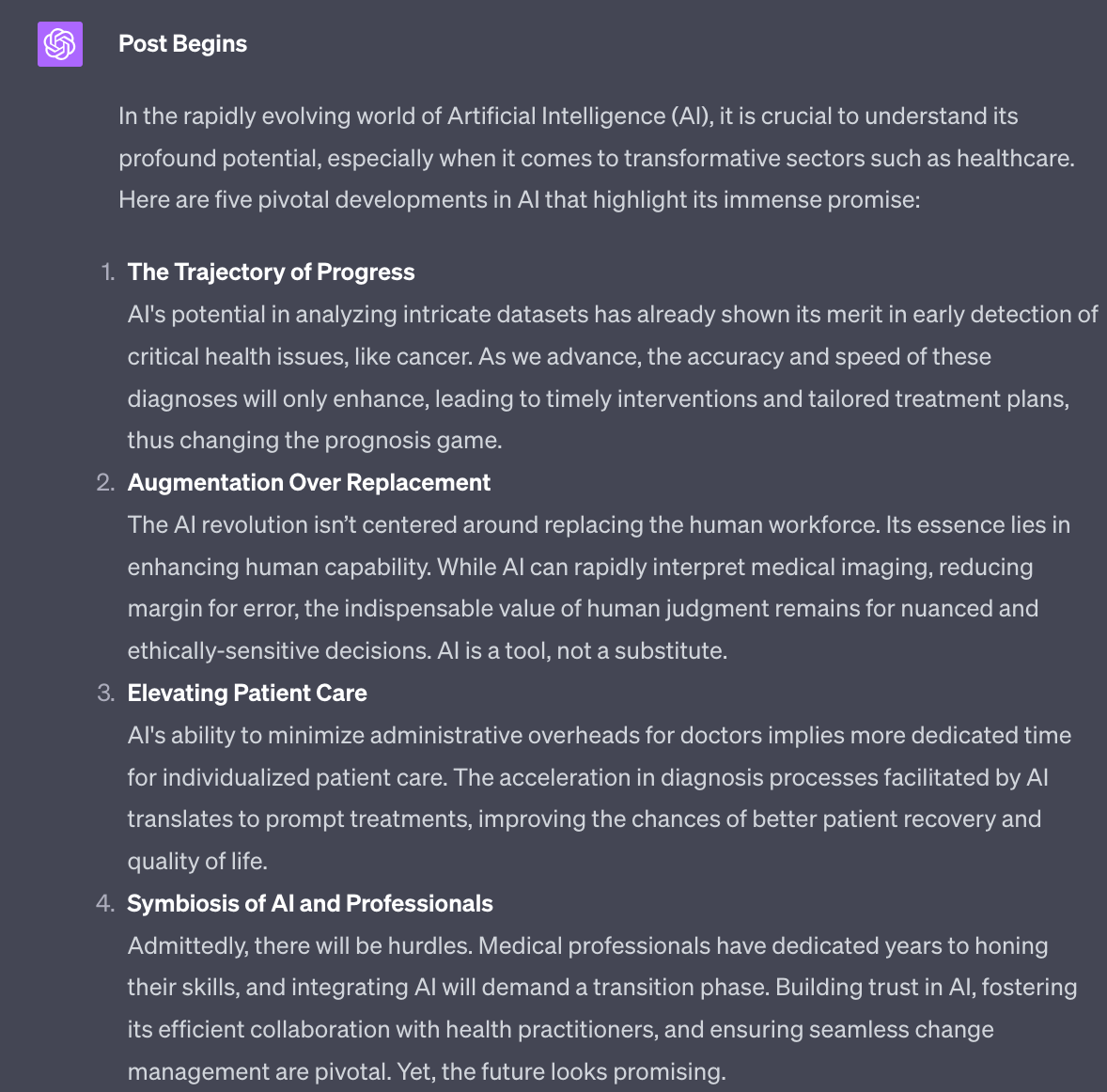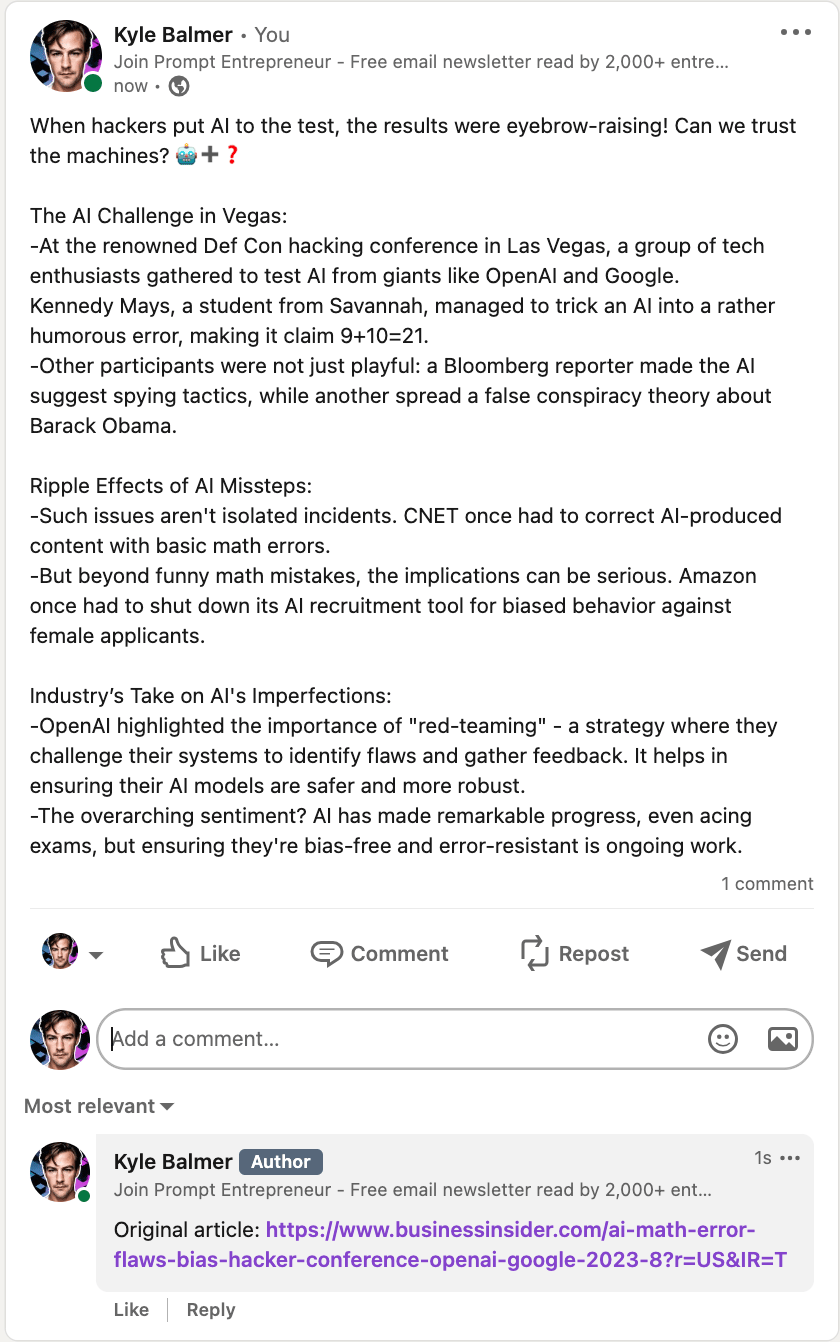Hey Prompt Entrepreneur,
We’ve got our basic LinkedIn profile set up and optimised for our niche.
We’re now going to begin creating content. I’ll walk through a few different methods you can use to get your content machine up and running.
Let’s get started:
LinkedIn Content Creation
1. Original content matrix
First we’re going to use ChatGPT to generate a content matrix with potentially unlimited content ideas for us to work with:
Act as a social media manager.
Create a content matrix with the following parameters
Core Topic = [Your large topic from Part 1]
Secondary topics = [Your medium topics from Part 1]
Tertiary topics = [Your small topics from Part 1]
All content pieces should be about the core topic. Include secondary and tertiary for variety, with preference for secondary.
For each content piece generate a post with the following formats/tones:
-Question for audience
-Controversial opinion
-Inspiring
-Entertain / joke
-X vs. Y comparison
-Expert opinion
-Listicle
Generate 10 content pieces on the vertical axis, each piece in all 7 formats/tones.
Return results in a tabular format.
Prompt Output 💬

This output shows the large topic (AI) mixed with my first medium topic (ChatGPT). The full output will include all of your medium and small topics giving you ~50-100 post ideas depending on how many topics you put in.
If you find the ideas a little generic I suggest adding some more information about your target audience. For example if I add in a line saying “Target audience = business leaders and owners” all ideas are immediately tweaked to address this audience.
These ideas are only the starting point – use them as a jumping off point rather than simply copy/pasting.
For example:
“Have you ever had a chat with ChatGPT? What was your most memorable conversation?“
I would rewrite as “Do you remember losing your ChatGPT virginity? What was your first ever conversation like?”
Similar idea but rewritten to add more bite.
Additionally, these topics can now be addressed in a quick text post or in a different format. For example each of these could be a quick video, a set of images or even a longer form LinkedIn blog post.
You can convert any of these ideas into these formats with a quick ChatGPT prompt to “reformat as a video script”, “ reformat as image slides” or “reformat as a blog article”.
2. Rewrites
This second method involves finding content that is killing it on LinkedIn and rewriting it for you particular niche.
Do not just copy wholesale. It’s lazy and won’t work.
Instead we want to find content that we can truly adapt and make our own. We are just building off the format and style of existing posts to help guarantee reach and engagement for ourselves.
In Part 1 we followed a number of top LinkedIn influencers in your topic area. As you use LinkedIn you should be seeing their content in your feed.
If you see anything that resonates with you and that you’d like to cover keep a reminder. You can do this using LinkedIn’s built in Save tool (tap the … at the top right of the post and hit Save) or by copy pasting the link to your note taking software.
I like to save up 10+ posts like this and then batch rewrite once a week. Do what works best for you.
To rewrite head to ChatGPT or Claude 2 (I prefer Claude 2 for this specific task) and use this prompt:
Act as a LinkedIn expert writer.
Rewrite this post.
Rewrite it so that the primary topic is AI.
Use a professional and authoritative expert tone of voice.
Remove links, mentions and hashtags.
#Post begins#
[Copy/paste post]
#Post ends#For the example I’ve used this post:

Prompt Output 💬

As always, rewrite rather than simply copy and paste.
Better yet convert the format. This is more work obviously but this means you are converting not only the content itself but also the formatting. This can work especially well if you are comfortable with video creation.
3. Curation
Another expert play is to stay on top of updates in your field and quickly convert new developments into social posts.
Very few people have the time to keep up with all new developments. So having someone quickly drop a “here’s what you missed today” post can be extremely valuable.
To do so you’ll need to have a set of sources. Industry specific websites, newsletters and Reddit are great sources. You want to find somewhere that has new developments early. Once you have found these add them to an app like Feedly to keep everything in one place.
Use this prompt:
Act as a content writer
Read the provided article and generate a summary for use on social media
Follow these structure guidelines
#structure guidelines Begin#
Introduction: Introduction to the core topic, emphasizing the primary subject or event. Use a hook to engage attention.
Link to Content: Source link, video, or external reference that the content is derived from or related to.
Deep Dive into Main Topic:
-Description of the main event, phenomenon, or development.
-In-depth details or backstory about the participants, stakeholders, or the origin of the event.
-Interactions, collaborations, or conflicts that define the main topic.
Consequences or Impacts:
-Specific examples or cases showcasing the implications or manifestations of the main topic.
-Broader societal or industry-wide effects, indicating long-term importance.
Responses or Reactions:
-Responses from authoritative entities, organizations, or experts about the event.
-Emphasis on immediate or future actions that might be taken.
-Warnings, concerns, or projections for the future.
Do not use these instructions as headers - instead create engaging, readable subheadings from the content.
#Structure guidelines end#
#Article begins#
[Copy paste article]
#Article ends#
Prompt Output 💬

The output becomes a ready to go summary of the article itself.
Make sure to link to the original article – do so in the Comments not the actual post. This is because LinkedIn’s algorithm deprioritises posts with links.
Don’t just try to pass off the content as your own – instead link back to the content and be clear that you are simply summarising and surfacing the information for your LinkedIn followers.
4. Hashtags and Call to Action
Unlike most social platforms hashtags are still relevant and used on LinkedIn.
You researched hashtags when looking at Topics in Part 1 so should have a list.
Stick to your large, medium and small topics as we previously discussed and add the most relevant of them to each post.
Aim for 3-5 maximum, don’t try to stuff hashtags. Just add them to the bottom of your post. Use your large topic in all your posts followed by 1-2 medium topics and 2-3 small topics. Make sure they are relevant to the actual content.
Also think about adding a call to action into your posts. Don’t do this on all posts – only perhaps 20% or so.
This call to action could be to Follow you on LinkedIn or to DM for introduce yourself and say hi. It could also be to sign up for your newsletter or a free lead magnet. Don’t sell in your posts – we’ll talk about monetisation in Part 5. But feel free to add a small low-commitment action for the reader to follow.
5. Posting
When and how often to post are always big questions for anyone starting out on a new social platform.
The true answer only comes from analysing your data. For example I know I get the most views and engagement on Tuesdays. Why? I don’t know – and it doesn’t really matter why. The main thing is the data shows me that so I make sure that Tuesdays’ content is top form.
We’ll look at how to analyse your data using ChatGPT in Part 4.
However, to get started we need some guidelines.
Aim first for consistency above all things – you want to be posting daily at minimum. I personally post 3-5 times per day now I have a system.
There’s a lot of talk about LinkedIn punishing overposting but I’ve never personally seen a downside – the more quality I post the higher the reach and the higher the engagement. I’ve also never seen an in-depth analysis to show that lower posting volume is preferable.
Just maintain quality and you should be fine.
Our “best day” to post therefore become irrelevant – post consistently everyday.
The best time of day to post tends to be around lunchtime. LinkedIn is a “professional” platform so people often use it at work. But they seem to use it around lunch hour rather than in core working hours.
This holds if your audience is in one location. If they are global then really all bets are off. For example the majority of my audience is USA but because I’m UK based and have a fair few Chinese and Indian followers I’m basically spread across all time zones!
Again, posting 3-5 times a day everyday allows you coverage over the multiple time zones and makes timing posts exactly less of a priority.
Thankfully LinkedIn has a built in scheduling tool (praise be!) so you can easily schedule posts to go at different times of day.
If you want something a little more sophisticated though I suggest Taplio (Affiliate link, fyi). It’s what I personally use and recommend if you want something more robust than the built-in LinkedIn scheduling. It also has AI assistance for writing content and a lot more.
Pulling it together
You are now equipped with 3 basic methods for creating content for LinkedIn : original content, rewriting and curation. All aided by ChatGPT using the prompts above.
Experiment with the methods to work out which you like best and then start posting. We need to start building up a streak of consistency for the LinkedIn algorithm to kick in.
Initially schedule one post a day just to get a nice base of consistent content. As you become more comfortable and faster you can begin to increase your output.
You should start seeing you views and engagements kick off within a couple of days. If not keep pushing and wait for the algorithm to notice you.
In the next part, we will discuss how to start connecting with others on LinkedIn to reach more people and start building relationships.
Part 1: LinkedIn Niche
Part 2: LinkedIn Content Creation
Part 3: LinkedIn Audience Engagement
Part 4: LinkedIn Growth
Part 5: Monetising LinkedIn
